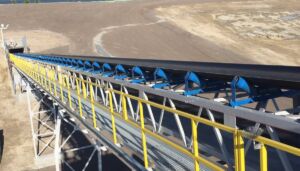Like any type of machinery, conveyor belt systems will eventually experience issues from time to time. Regardless of how well-maintained conveyor belt parts are, it’s normal to face problems, especially given that conveyor belts are one of the most used pieces of equipment across many industries.
While some problems are bound to happen, there are ways to prevent common issues and extend the life of your conveyor belt parts. Below are some of the most common conveyor belt problems and ways to prevent them.
Material spillage
Material accidentally sliding, rolling, or spilling over is inevitable, especially for productions that move a lot of loose or heavy products. However, if your conveyor system is experiencing an increase in spillage incidents, it could be an issue with areas that are causing excess shaking or rattling.
To prevent material spillage, be sure to keep your conveyor system well-maintained. Clean the conveyor belt and parts regularly and consider installing impact beds.
Seized rollers
Excessive material spillage is the most common cause of seized rollers, which can halt production altogether. To prevent this downtime, we recommend installing Luff’s patented High Moisture Seal & Anti-Lock Shield. This polymer disc sits inside the end cap and remains stationary as the roller rotates around it, allowing the roller to turn freely, even with material built up between the roller end and the conveyor idler.
In addition to Luff’s High Moisture Seal & Anti-Lock Shield, you can prevent seized rollers by carefully inspecting them on a regular basis. This should be part of your regular maintenance routine.
Material blockage
Material blockage can happen due to wear and tear on the conveyor belt, sharp edges, and weak points in the system. When blockages happen, they can cause the conveyor belt to simply stop moving.
To avoid this issue, again be sure to keep a well-maintained system. Inspect your conveyor belt for any holes, weak points, and sharp edges that could potentially cause a blockage and have them repaired as soon as possible. Another solution to prevent material blockage is to install guide rollers which help reduce the chance of severe belt damage from sharp edges.
Mistracked conveyor belt
Mistracking happens when the belt moves too far to one side, which can lead to material spillage, material blockage, and cause premature wear on other conveyor belt parts. A mistracked conveyor can throw off the entire system The best way to prevent a mistracked conveyor is to have inspections and adjustments done on a regular basis. If you notice small signs of misalignment such as uneven belt wear, address them immediately before they become bigger problems.
To sum it up, some of the most seemingly small issues can turn into bigger problems that can halt operations. These common issues can be prevented and solved with simple conveyor belt parts and accessories.




